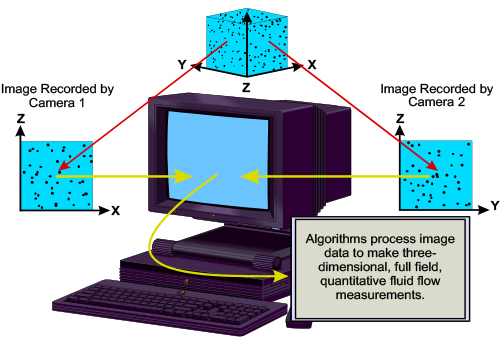Designing It Smart With SIV
When research staff at NASA's Glenn Research Center developed and patented Stereo Imaging Velocimetry (SIV), the world's first three-dimensional (3-D), full-field quantitative and qualitative analysis tool to investigate flow velocities, experiments that were previously impossible became a reality. Seizing the opportunity to commercialize NASA's breakthrough invention, Digital Interface Systems (DIS), Inc., of North Olmsted, Ohio, acquired an exclusive license to market SIV, which has a range of applications from improving the aerodynamics of aircraft and automobiles to avoiding "no flow" regions in artificial hearts.
NASA Glenn's SIV is a safe, affordable means to obtain 3-D flow information from any transparent liquid that can be seeded with tracer particles. Previously, accurate information of this type was very difficult to obtain and often required using dedicated laser-based measurement systems. Eliminating the need for lasers, SIV provides an effectively nonintrusive measurement of 3-D fluid velocities at many points and at high frame speeds using two charge coupled device (CCD) video cameras and neural networked-based computational algorithms. It allows for the direct comparison of computed and experimentally measured fluid flows, with no limitation on the fluid flow scale to be measured.
The five distinct steps in the SIV method include camera calibration, centroid/overlap decomposition, particle tracking, stereo matching, and 3-D analysis. The CCD cameras are oriented at 90º with respect to each other in order to observe a fluid experiment that has been seeded with the small tracer particles. Each camera records two-dimensional (2-D) data of the particles' motion in the observation volume. Users obtain the 3-D data by computationally combining the 2-D information from both cameras. The SIV method incorporates a camera-calibration technique in which rotation and translation of camera lenses and optical distortion generated in the lenses are taken into account using the accurate 2-D- to 3-D-mapping function.
SIV applies to diverse experiments such as the study of multiphase flow, bubble nucleation and migration, pool combustion, and crystal growth. The technique successfully analyzed data from two Space Shuttle missions. Several of NASA's ground-based experiments are also benefiting, as SIV is applied to the Agency's microgravity program for fluid physics experiments.
In the commercial marketplace, SIV applies to industrial process optimization and the design of new products. It helps companies to create more efficient heating, ventilating, and air conditioning systems, as well as quieter airflow within auto heating and cooling ducts. The technology can assist with air flow studies around buildings and the modeling of continuous casting operations. SIV has been used in the steel industry to quantify the continuous casting process, the vacuum cleaner industry to observe brushroll designs, and in the sporting goods industry to investigate the bat-ball impact phenomenon of softball bats.
SIV is available through DIS as an on-demand World Wide Web deployable program or as a mini-compact disc version, with robust, user-friendly, graphical user interface enhancements that enable easy navigation of the tool.

This diagram shows a fluid experiment seeded with tracer particles. Two cameras are set up perpendicular to each other, recording two widely disparate views. The two views are computationally combined to obtain three-dimensional coordinates of the seed particles













